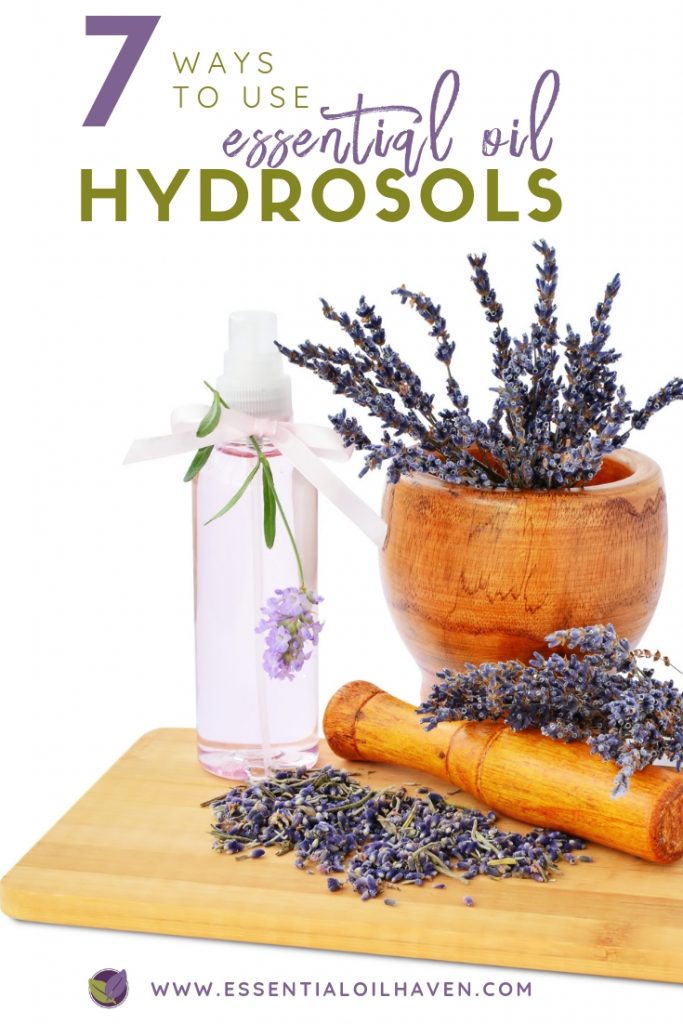
This guide to essential oil hydrosols provides you an overview and explanation of what hydrosols are, what they are used for, and how you can use them to support your essential oils practice at home.
What is a Hydrosol?
During steam distillation of essential oils, a scented water is the by product of this process. Imagine a big steam boiler, where the plant materials are added. A certain amount of water is added to create the steam. The water/plant material mixture is heated and pressurized, and that extracts the natural oils from the plant.
This post contains affiliate links, which means if you make a purchase through these links, I may receive a small commission at no extra cost to you. Read my full disclosure policy here.
While the water/steam works to get the oils out of the plant, the water itself also permeates the plant materials, picking up traits and properties of said plant. This essential water is then called Hydrosol, or Floral Water – a by-product of essential oil steam distillation. Both essential oils and hydrosols are being collected in the same boiler.
Do Hydrosols Have Healing Properties?
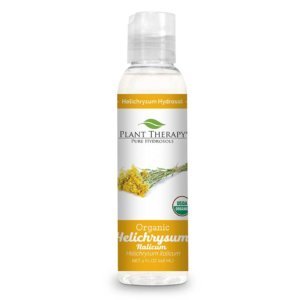
Organic Helichrysum Hydrosol from Plant Therapy
Shop Now
Yes, essential oil hydrosols possess the same healing properties as the essential oil made from that plant, but in less strength and potency. The scent notes usually differ quite a bit too, between hydrosol to essential oil.
Hydrosols are basically a softer and gentler version of their essential oil counterpart, which makes them a great choice for treating children, people with sensitive skin, or the elderly. They are safe to apply directly to your skin, and are therefore a great option for body mists or skin care formulas.
How Safe Are Hydrosols?
Hydrosols don’t come with the same safety precautions as essential oils. While essential oils are the highly concentrated part of the plant, hydrosols are a very diluted version of the plant. Also, due to the steam distillation process, different components of the plant are contained in the water, versus what makes up the oil.
Hydrosols are therefore very safe to use in all applications that call for caution with essential oils. This includes direct application to the skin, use on sensitive skin, use with children and even babies, or use for the elderly. Hydrosols are a great option to reach for in these cases, where the essential oil is considered too strong.
How do I use Hydrosols?
Hydrosols are a great choice to use in many DIY essential oil recipes, such as for cleaning, skin care, or perfume. If you’re wondering how to use hydrosols as part of your essential oils home, here are a few of my favorite ideas:
1. Body mist / perfume
Hydrosols, straight up, can be spritzed onto your body just like a perfume would. If you’ve found a hydrosol that you like the scent of, simply spritz it onto your inner wrists, behind your ears, or onto your chest as a body perfume. It doesn’t have to apply directly to your skin, even though it is safe to do so. Spritzing over top of clothes is totally fine, too. Neroli hydrosol is a popular choice as its perfume is pleasing to most. Neroli is also a great support for emotions of anxiety and depression, so you can double its use to not only smell amazing, but also to help your emotional well-being that day and lower the nervous tensions in your body.
2. After Sun Skin Care
Since hydrosols are super gentle on your skin, I like to use them in essential oil body care recipes such as this after sun skin care spray. They make a great watery base addition, while adding therapeutic properties to the mix.
3. Linen Spray
Hydrosols are fantastic to use as linen sprays, especially bedroom linens like the pillow or comforter. Frankincense (get it here) and Lavender (buy here) would be nice bedtime linen hydrosols to use. Use them individually or combined to find your way into dreamland faster. Frankincense is grounding and inspires calmness; Lavender provides emotionally calming support.
4. Treating Children
Using hydrosols around kids, you can also spray some calming hydrosol like Lavender or German Chamomile on a child’s pillow before bedtime for a soft passive “diffusing” effect to help your child go to sleep. German Chamomile especially is relaxing and soothing for little ones, and therefore quite a popular choice. Lavender and German Chamomile are so gentle that they can be used on very small children and babies. For babies under 6 months, please consult your doctor or Certified Aromatherapist.
5. Carpet freshener
Lavender and Peppermint hydrosols are effective disinfectants, and when used in a carpet spray or upholstery spray, can really lift up the freshness in a room. Put away the Febreze (sorry!) and grab a bottle of Lavender Hydrosol here.
6. Cleaning products
Tea tree hydrosol (like this one here) would be an excellent choice for natural cleaning products.
7. Skin care
Since hydrosols are very gentle, they are great for skin care, especially also for facial applications where the skin is thinner and more sensitive to begin with.
Rose hydrosol is famous for its beautiful smell and makes an easy facial toner without the need for any further recipe. It hydrates the skin and soothes irritations and red spots, providing overall amazing support for the skin.
If you prefer a more grounding facial spray or skin care smell, you can also go for Vetiver hydrosol. It is a base note in aromatherapy and will therefore be more grounding and meditative rather than the somewhat lighter floral middle-base note of Rose.
In Summary
I hope this guide to essential oil hydrosols has helped you understand these beautiful floral waters just a little bit better, and how you can use them to support your naturally healthy home. If you have any questions, please let us all know by commenting below, and our community will surely find a way to help you out! Also, join us on Facebook, Twitter or Instagram to chat!
Love This Article? Why Not Pin It To One Of Your Favorite Pinterest Boards!
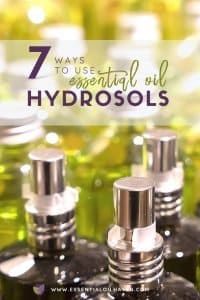



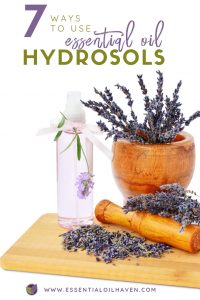
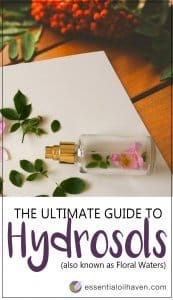
I’m not really sure. I have never heard of this concept before. I would like to learn more about the hydrosols.
Hi
I have vanilla essential oil and patchouli hydrosol.
Is there any way a hydrosol and an Essential oil can be mixed together to be used on skin.